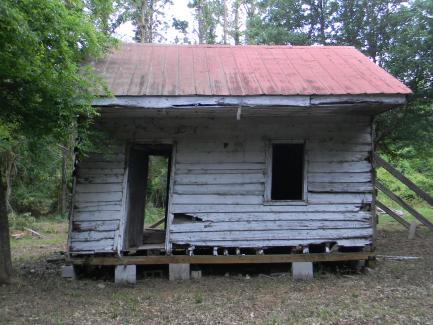Family of the Inhabitants of the Edisto Island Slave Cabin Visit the National Museum of African American History and Culture
Isabell Meggett Lucas, 86, and Emily Hutchinson Meggett, 84, two matriarchs of the Meggett family of South Carolina, were among 25 Edisto Island residents who visited the Smithsonian’s National Museum of African American History and Culture for the first time yesterday, April 10.
Lucas was born in the Edisto Island cabin, which is prominently featured in the “Slavery and Freedom” exhibition in the museum. Her sister-in-law, Meggett, grew up in a family-owned house nearby. The cabin is prominently displayed in the history galleries of the museum where it helps tell the story of slavery and freedom in the 19th century.
The two-room wood cabin dates to the 1850s, and members of the Meggett family inhabited the cabin from about 1910 until as recently as the 1980s. Meggett is the wife of the deceased Jessie Meggett, who grew up in this former slave cabin in South Carolina. Several generations of the Meggett family joined the 87-year-old to view the cabin exhibit for the first time. This emotional experience was captured by the Smithsonian oral-history project; the filmed interviews will be preserved as a part of the living history of this cabin.
“We are delighted to host the Meggett family at the museum,” said Nancy Bercaw, co-curator of the “Slavery and Freedom” exhibition. “This is a milestone in the life of the museum—being able to truly humanize an object on display; this cabin is more than a cabin; it is a home. While the current exhibition features the cabin as it was used during the period of slavery and emancipation, we see the cabin as a living object that holds hundreds of truly moving stories about the people who lived in it from 1853 to 1981. Having this cabin on view is a powerful way for museum visitors to learn about the Meggetts and other families who lived on Edisto in the 20th century.”
“It was so exciting, so exciting,” Lucas said. “I never thought I’d see a house that I lived in be in a museum…not in my lifetime. People can look at that house and the pictures around it and know that everything didn’t come easy back then.”
“All of us living in there (in the Meggett family row of cabins), we were all together—like family,” Meggett said. “We played together, ate together; the kids, we would fight together, learn together.…We never talked about slavery. We never talked about being poor. And we never went to bed hungry.”
The Edisto Island cabin was acquired by the Smithsonian in 2013 and dismantled plank by plank and reassembled in the museum. The Edisto Island Historic Preservation Society donated the cabin to the Smithsonian after originally receiving it from the Burnet Maybank family, which owned the Point of Pines Plantation where the cabin was built and used to house people who worked the fields. The exact age of the cabin is not known, but records show that in 1853, it stood on the site of the plantation from where it was dismantled. The Edisto Island Slave Cabin exhibit has been one of the most popular exhibits for visitors of the National Museum of African American History and Culture.
About the National Museum of African American History and Culture
The National Museum of African American History and Culture opened Sept. 24, 2016, on the National Mall in Washington, D.C. Occupying a prominent location next to the Washington Monument, the nearly 400,000-square-foot museum is the nation’s largest and most comprehensive cultural destination devoted exclusively to exploring, documenting and showcasing the African American story and its impact on American and world history. For more information about the museum, visit nmaahc.si.edu, follow @NMAAHC on Twitter, Facebook, Instagram, and Snapchat or call Smithsonian information at (202) 633-1000.
# # #
SI-211A-2017
Fleur Paysour
202-633-4761


